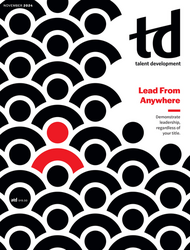TD Magazine Article
Authoring Tools, November 2024
Authoring tools can assist with developing dynamic training content.
Published Fri Nov 01 2024
E-learning and virtual reality are among various training methods designers can leverage to improve training programs. With the use of authoring tools to assist with developing dynamic training content, talent development teams can enhance their training portfolios.
Since the early days of e-learning, instructional designers have been the main creators of e-learning content. However, they often work within learning departments separate from business operations. That poses challenges, particularly with business-related training courses, where instructional designers rely on time-consuming interviews with subject matter experts to gather information. Moreover, instructional designers may struggle to update courses with the latest business changes.
If SMEs create the content instead, that solves the problems. That strategy is called Employee-generated Learning. It is faster, and SMEs are better suited to keep the content updated. It is also a great way to stimulate and democratize knowledge sharing. However, Employee-generated Learning comes with its own obstacles. SMEs may face time constraints and lack the instructional design expertise to produce high-quality learning content.
As a solution, new authoring tools have emerged specifically designed to empower SMEs. Such tools boast user-friendly interfaces and are now integrating artificial intelligence functions to help SMEs create effective e-learning content more efficiently—solving the challenges regarding time and quality.
As those tools evolve, they could significantly shift the e-learning landscape. With SMEs taking a more central role in developing business-related learning content, the reliance on traditional instructional designers could reduce.
easygenerator.com
Virtual reality is transforming corporate learning by creating immersive training experiences that enhance skill retention and engagement. Unlike traditional methods, VR tricks the brain into perceiving virtual scenarios as real, enabling employees to practice skills in a safe environment. This immersive approach not only boosts information retention but also prepares workers for real-world tasks.
Gamification is one effective application of VR in training. For instance, KFC’s The Hard Way program combines e-learning with gamified elements, teaching employees how to prepare chicken through interactive mini-games. Similarly, Ford uses VR to help technicians diagnose engine issues by exploring a virtual Mustang Mach-E engine.
Another crucial aspect is providing a safe learning space. High-risk industries benefit from VR by enabling employees to experience hazardous situations without real danger. ExxonMobil’s Digital Garage enables oil and gas operators to navigate complex scenarios safely, while UPS uses VR to train drivers on company protocols.
Finally, VR helps close the soft skills gap essential for modern workplaces. Companies such as H&R Block and Walmart use VR for role-playing exercises that enhance communication and leadership skills, leading to improved customer interactions and employee assessments. As more organizations adopt VR, its role in corporate learning will undoubtedly expand.
elblearning.com
You've Reached ATD Member-only Content
Become an ATD member to continue
Already a member?Sign In



